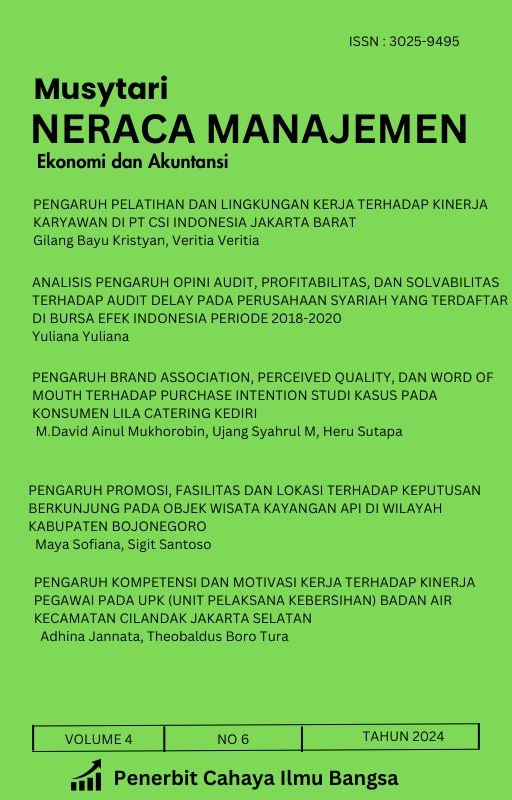IMPLIKASI KENAIKAN TARIF PPN 12% BAGI PRAKTIK MANAJEMEN PERPAJAKAN: STUDI KUALITATIF PADA SEKTOR BISNIS INDONESIA
Published 2025-06-13
Keywords
- 12% VAT,
- tax management,
- fiscal policy,
- tax planning,
- MSMEs
- inflation,
- purchasing power,
- tax digitalization ...More
How to Cite
Abstract
The policy of increasing the Value Added Tax (VAT) rate from 11% to 12% by 2025 is one of the strategic steps of the Indonesian government in strengthening state revenue and achieving sustainable fiscal consolidation. This policy not only aims to increase Indonesia's tax ratio, which is still relatively low compared to other developing countries, but also to prepare a strong fiscal foundation in the face of increasingly complex global economic challenges. However, the implementation of this policy has very complex and multidimensional implications for various economic sectors, the business world from micro to macro scales, as well as tax management practices that must adapt to these regulatory changes.
This study aims to analyze in depth the impact of the increase in VAT rates on public consumption, national inflation rates, investment climate, and state revenues in the context of short and long term. The main focus of this research is on the managerial responses needed to address the various challenges that arise, including adaptation strategies that can be implemented by various relevant stakeholders. The method used is a qualitative-descriptive approach based on a comprehensive literature study with a critical analysis of various relevant secondary data sources.
The results of the study show that although this policy is theoretically able to significantly increase state revenue with an additional estimate of Rp60-70 trillion per year, there are consequences that cannot be ignored on people's purchasing power, the stability of the prices of goods and services, and business sustainability, especially in the Micro, Small, and Medium Enterprises (MSMEs) sector which is the backbone of the Indonesian economy. The regressive impact of VAT has the potential to increase economic inequality and put disproportionate pressure on low-income communities.
Therefore, comprehensive strategies such as effective and structured tax planning, accelerating the digitalization of the national tax system, intensifying tax education programs to increase public tax literacy, implementing special protection policies for MSMEs, and strengthening risk-based supervision systems are crucial to ensure the success of these policies in a sustainable manner without sacrificing economic stability and community welfare.
References
- Badan Pusat Statistik. (2023). Laporan PDB dan Konsumsi Rumah Tangga Triwulan IV 2023. Jakarta: BPS.
- Bank Indonesia. (2024). Laporan Stabilitas Ekonomi Makro Indonesia 2024. Jakarta: Bank Indonesia.
- Bird, R. M., & Zolt, E. M. (2003). Introduction to Tax Policy Design and Development. Washington, D.C.: World Bank Publications.
- Caesaria, S. M., Mumpuni, Y. T., Mayasha, E., & Murti, G. T. (2024). Analysis of the Impact and Implications of the VAT Rate Increase in Indonesia. Jurnal Indonesia Sosial Teknologi, 5(8), 1150-1165. https://doi.org/10.59141/jist.v5i7.1150
- Feld, L. P., & Frey, B. S. (2007). Tax compliance as the result of a psychological tax contract: The role of incentives and responsive regulation. Law & Policy, 29(1), 102–120.
- Kementerian Keuangan RI. (2022). Undang-Undang Harmonisasi Peraturan Perpajakan No. 7 Tahun 2021. Jakarta: Kemenkeu RI. https://jdih.kemenkeu.go.id/dok/uu-7-tahun-2021
- Kementerian Keuangan RI. (2024). Outlook APBN 2025: Mendorong Transformasi Ekonomi Menuju Indonesia Maju. Jakarta: Kemenkeu RI.
- Kusumawardani, D., & Ratnasari, A. (2022). Dampak Perubahan Tarif PPN terhadap UMKM di Indonesia: Analisis Kualitatif dan Kuantitatif. Jurnal Ilmiah Pajak Indonesia, 4(1), 55–66.
- Mankiw, N. G. (2018). Principles of Economics (9th ed.). Boston: Cengage Learning.
- Mardiasmo. (2018). Perpajakan: Teori dan Aplikasi (Edisi Revisi). Yogyakarta: Penerbit Andi.
- Musgrave, R. A., & Musgrave, P. B. (1989). Public Finance in Theory and Practice (5th ed.). New York: McGraw-Hill.
- Ricardo, M., & Tambunan, M. R. U. D. (2024). Tantangan dan Strategi Penerapan Kebijakan Tarif PPN 12% di Indonesia. COSTING: Journal of Economics, Business and Accounting, 7(5), 1247-1265. https://doi.org/10.31539/costing.v7i5.11917
- Rita, & Astuti, P. (2023). Dampak Kenaikan Tarif Pajak Pertambahan Nilai Terhadap Inflasi dan Stabilitas Ekonomi. REMITTANCE: Jurnal Akuntansi Keuangan dan Perbankan, 4(1), 87-102. https://doi.org/10.56486/remittance.vol4no1.279
- Samuelson, P. A., & Nordhaus, W. D. (2015). Economics (19th ed.). New York: McGraw-Hill Education.
- Sastri, I. D. A. M. M., Datrini, L. K., Pertamawati, N. P., & Yoga, I. G. A. P. (2024). Increasing Value Added Tax (VAT) Rates on Community Purchasing Power and Economic Stability: Evidence from Indonesia. Journal of Economics, Finance and Management Studies, 7(6), 2301-2315. https://doi.org/10.47191/jefms/v7-i6-40
- Soemitro, R. (2005). Manajemen Perpajakan: Strategi dan Implementasi. Bandung: Eresco.
- Tait, A. A. (1988). Value Added Tax: International Practice and Problems. Washington, D.C.: International Monetary

